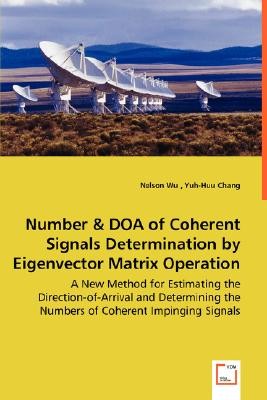
- We will send in 10–14 business days.
- Author: Nelson Wu
- Publisher: VDM Verlag Dr. Mueller E.K.
- Year: 2008
- Pages: 68
- ISBN-10: 3639000323
- ISBN-13: 9783639000320
- Format: 15.2 x 22.9 x 0.4 cm, minkšti viršeliai
- Language: English
- SAVE -10% with code: EXTRA
Number & DOA of Coherent Signals Determination by Eigenvector Matrix Operation - A New Method for Estimating the Direction-of-Arrival and Determining the Numbers of Coherent Impinging Signals (e-book) (used book) | bookbook.eu
Reviews
Description
The research of signal parameter estimation using antenna array have been extensively attended for decades. In array processing, the estimation of DOA( Direction of Arrival ) or the determination of number of signals plays an important role in many applications such as in sonar, radar, and seismic measurement. However, the concept of most known algorithms is assuming the signals are uncorrelated. In practice, the transmitting signals are usually reflected or refracted by mountains, buildings or other impediments. It will cause multi-path propagation as highly correlated or coherent signals are received on the sensor.Therefore, rank deficiency of signal covariance matrix will be raised.It will cause the usual eigenvalue-detecting method going failed. In this book, we propose a new method for the rank deficient issue. For avoiding the confusion caused by the unknown length of subarray, we use some operations of the eigenvector matrix to form a new matrix. Besides, we can find out the number of signals by counting the non-zero eigenvalues of the covariance matrix of this new matrix. Furthermore, we also can categorize the coherent signals into different groups for their coherence.
EXTRA 10 % discount with code: EXTRA
The promotion ends in 23d.13:02:54
The discount code is valid when purchasing from 10 €. Discounts do not stack.
- Author: Nelson Wu
- Publisher: VDM Verlag Dr. Mueller E.K.
- Year: 2008
- Pages: 68
- ISBN-10: 3639000323
- ISBN-13: 9783639000320
- Format: 15.2 x 22.9 x 0.4 cm, minkšti viršeliai
- Language: English English
The research of signal parameter estimation using antenna array have been extensively attended for decades. In array processing, the estimation of DOA( Direction of Arrival ) or the determination of number of signals plays an important role in many applications such as in sonar, radar, and seismic measurement. However, the concept of most known algorithms is assuming the signals are uncorrelated. In practice, the transmitting signals are usually reflected or refracted by mountains, buildings or other impediments. It will cause multi-path propagation as highly correlated or coherent signals are received on the sensor.Therefore, rank deficiency of signal covariance matrix will be raised.It will cause the usual eigenvalue-detecting method going failed. In this book, we propose a new method for the rank deficient issue. For avoiding the confusion caused by the unknown length of subarray, we use some operations of the eigenvector matrix to form a new matrix. Besides, we can find out the number of signals by counting the non-zero eigenvalues of the covariance matrix of this new matrix. Furthermore, we also can categorize the coherent signals into different groups for their coherence.


Reviews